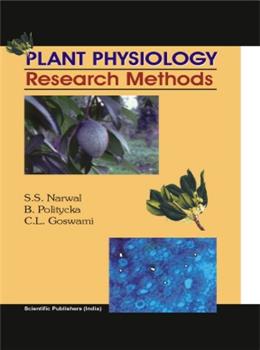Plant Physiology Research Methods

- ISBN
- Book Format
- Binding
- Language
- Edition
- Imprint
- ©Year
- Pages
- Size (Inch)
- Weight
| Select | Format | INR(₹) |
|---|---|---|
| Print Book | 2,850.00 |

| Select | Format | INR(₹) |
|---|---|---|
| Print Book | 2,850.00 |
This book 28 Chapters, is divided into 7 Sections. Section I. Seed Physiology, includes 5 chapters describing the structure of seed, optimum conditions for seed germination, physiological and biochemical changes at cellular level. Section II. Growth and Development, describes leaf area, growth indices, senescence and abscission. Allelochemicals, present in soil or plant, can create chemical stress which may change the plant water status, plasma membrane properties, chlorophyll stability and waxes present on the organ surface. Methods to determine all these parameters are described in next 4 chapters in Section III. Stress Physiology. These sites can be explored by estimating chlorophyll content, chlorophyll fluorescence, photo-systems I and II activity, carbon dioxide exchange rate, activity of CO2 fixing enzymes, intermediate metabolite level, photosynthate partitioning, respir-ation and finally the crop growth dynamics. Methods to determine extent of all these sites are explained in 7 chapters in Section IV. Gas Exchange Processes. The main cause of changed physiological process is at the gene level, for which estimation of nucleic acids is very critical. It is briefly expl-ained in section V. Biochemical Estimation. Section VI. Microtomy and Histochemistry, has 7 chapters. Basic procedure to process the test plant material for microtomy, use of light and electron microscopy to study cellular changes, measurement of cellular dimensions, stomatal index and frequency, pollen viability and in vivo pollen germination and histochemical localization of important enzymes metabolites are the core topics. Currently, tissue cultures are commonly used to study the precise effect of allelochemicals on callus growth and differentiation. To achieve these objectives techniques of tissue cultures is described under section VI. Tissue Culture.
Section I. SEED PHYSIOLOGY
1. Seed structure and germination — O.S. Dahiya and Promila Kumari
2. Seed germination : optimum temperature, moisture and light — Promila Kumari and O.S. Dahiya
3. Seed germination : water uptake and cellular changes — A.L. Patel
4. Dormancy, seed viability and seedling vigour — Promila Kumari and O.S. Dahiya
5. Bioassy for seed germination and seedling growth — B. Politycka
Section II. GROWTH AND DEVELOPMENT
6. Leaf area — K.D. Sharma
7. Growth indices — C.L. Goswami
8. Senescence and abscission — C.L. Goswami
Section III. STRESS PHYSIOLOGY
9. Plants water status — R. Angrish and C. Rani
10. Membrane stability indices — R. Munjal and S.S. Dhanda
11. Chlorophyll stability index — Renu Munjal and C.L. Goswami
12. Leaf surface waxes — M.S. Kuhad
Section IV. GAS EXCHANGE PROCESSES
13. Leaf pigments — Swaraj Kumari
14. Chlorophyll fluorescence — S.S. Dudeja
15. PSI and PSII activities — H.R. Singal
16. Crop growth dynamics — R.K. Pannu and I.S. Sheoran
17. Respiration with Warburg’s apparatus — I.S. Sheoran
18. To measure photosynthate partitioning using labeled CO2 — I.S. Sheoran
19. Measurement of CO2 fixing enzymes and important metabolites — H.R. Singal
Section V. BIOCHEMICAL ESTIMATION
20. Estimation of nucleic acids — Veena Jain and Kamal Dhawan
Section VI. MICROTOMY AND HISTOCHEMISTRY
21. Light microscopy methods : Fixing, embedding, sectioning and staining — S. Babber
22. Electron microscopic : Scanning and transmission electron microscopy — S. Uppal
23. Cellular dimensions — H.R. Dhingra
24. Stomatal index and frequency — H.R. Dhingra
25. Pollen viability and in vitro pollen germination — H.R. Dhingra
26. Histochemical localization of important enzymes — Sunita Sheokand
27. Histochemical localization of important metabolites — S.C. Goyal
Section VII. TISSUE CULTURE
28.Tissue culture techniques — S. Babber
ANNEXURE
1-VII. Annexures — C.L.Goswami
Subject Index

SCIENTIFIC PUBLISHERS
"Granthlok"
5-A,Pali Road,
Bhagat Ki Kothi (Near Riktiya Bheruji Circle)
Jodhpur, Rajasthan
PIN - 342 001, INDIA
WhatsApp: +91-77339-04904
Enquiry: +91-95211-31111
Orders: +91-99292-72222
Publishing
Books: +91-97999-91782
Journals: +91-98299-89666
Tel: +91-291-2433323
DELHI
"Granthlok"
4806/24, Ansari Road, Bharat Ram Road, Darya Ganj New Delhi 110002 INDIA
Tel: +91-11-47590696
Email: info@scientificpub.com
Make sure you dont miss interesting happenings
by joining our newsletter program

Government e Marketplace (GeM) is a 100 percent Government owned & National Public Procurement Portal.GeM is dedicated e market for different goods.

© 2025 SCIENTIFIC PUBLISHERS | All rights reserved.